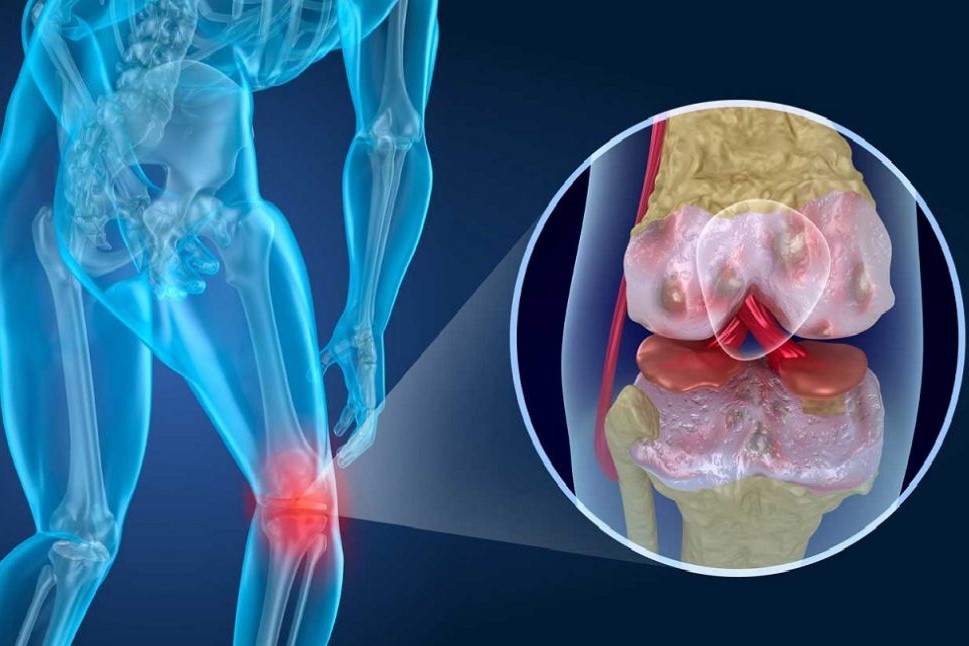
Arthritis: definition, diagnosis, treatment, and prognosis
Arthritis is the inflammation of the joints affecting males and females of all ages, the reaction occurring as a result of various diseases: viral or bacterial infections, autoimmune diseases, fractures, etc.
We speak more specifically of arthritis when, after treatment, joint pain remains and is sometimes also accompanied by permanent deformity of the joint itself.
Common causes of arthritis can be gout, scleroderma, lupus, osteoarthritis, psoriasis, bacterial or viral infections, rheumatoid arthritis, ankylosing spondylitis, etc.
Most cases of arthritis cannot be prevented
The only viable prevention is to limit the damage to the body.
Typical symptoms of arthritis are swelling and pain in the joint in question, reddening of the skin around the affected joint, limited movement of the joint, joint stiffness especially in the morning.
Diagnosis of arthritis
Physical examination of the patient generally highlights the presence of fluid around the joint (effusion); the joint may be swollen and warm, especially in cases of autoimmune disease or arthritis of infectious origin; and some difficulty in movement and rotation in certain directions may be noted.
In some autoimmune diseases, the joints, without proper treatment, may even become deformed, thus becoming the most tangible sign of severe arthritis.
Treatment of arthritis cases
Treatment varies depending on the type of arthritis one has, the severity of the condition, the joint affected, and the patient’s age, occupation, and activity.
However, the aim of treatment is to eliminate the primary cause of arthritis, although in some cases this is not possible because there is no cure (for example, this is the case in cases of scleroderma, rheumatoid arthritis, etc.).
In these cases, then, treatment aims to limit joint damage and pain.
Therapy usually relies on the administration of medication, combined with physical activity.
Medications tend to reduce joint swelling, pain, and inflammation; these are generally aspirin and other NSAIDs, corticosteroids, and immunosuppressive drugs.
NSAIDs are over-the-counter (anti-inflammatory) drugs and are often used to combat joint pain.
Although they are often prescribed, they have some undesirable effects, most notably causing stomach ulcers, bleeding of the digestive system, and kidney damage.
For this reason, NSAIDs should always be taken in consultation with your doctor and avoided in cases where there is already a medical history of kidney or gastrointestinal problems.
Corticosteroids (or steroids) target immunosuppression and are administered orally, in injections, or directly into the affected joint.
Usually, they are prescribed for the treatment of osteoarthritis and other autoimmune diseases (rheumatoid arthritis, lupus, scleroderma), but not for arthritis of infectious origin.
In some cases, surgery, with reconstruction or complete replacement of the affected joint, proves to be the most appropriate treatment.
Surgery is the therapeutic choice implemented when other treatments have failed.
To avoid, or postpone as much as possible, surgery, there is now another type of treatment, which is to inject synthetic synovial fluid directly into the joint to replace the natural synovial fluid that is lacking in arthritis.
Arthritis, the prognosis
Arthritis is usually a chronic, that is, lifelong condition; only some forms can be cured permanently.
Treatment, therefore, tends only to limit the progressive damage of the disease and reduce pain, but can do nothing about the damage that has already occurred.
Read Also:
Emergency Live Even More…Live: Download The New Free App Of Your Newspaper For IOS And Android
Shoulder Instability And Dislocation: Symptoms And Treatment
Shoulder Tendonitis: Symptoms And Diagnosis
Dislocation Of The Shoulder: How To Reduce It? An Overview Of The Main Techniques
Frozen Shoulder Syndrome: What It Is And How To Treat It
Arthrosis: What It Is And How To Treat It
Arthrosis: What It Is And How To Treat It
Juvenile Idiopathic Arthritis: Study Of Oral Therapy With Tofacitinib By Gaslini Of Genoa
Rheumatic Diseases: Arthritis And Arthrosis, What Are The Differences?
Rheumatoid Arthritis: Symptoms, Diagnosis And Treatment
Joint Pain: Rheumatoid Arthritis Or Arthrosis?
The Barthel Index, An Indicator Of Autonomy
What Is Ankle Arthrosis? Causes, Risk Factors, Diagnosis And Treatment
Unicompartmental Prosthesis: The Answer To Gonarthrosis
Knee Arthrosis (Gonarthrosis): The Various Types Of ‘Customised’ Prosthesis
Symptoms, Diagnosis And Treatment Of Shoulder Arthrosis
Arthrosis Of The Hand: How It Occurs And What To Do


